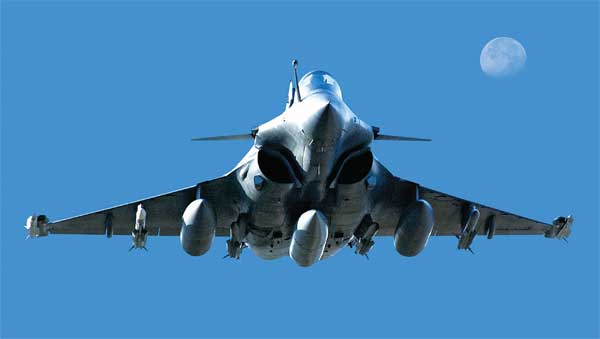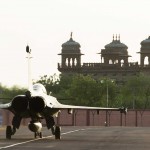How to assess the State Visit of a foreign dignitary?
After following for 2 days the visit of President Francois Hollande of France in Delhi earlier this week, it was the question I asked myself.
In December 2010, when President Nicolas Sarkozy came to India; after the ritual signatures of agreements at Hyderabad House, while travelling in the bus taking us back to the press room, a press councellor to the President was grilled by the French journalists, they wanted ‘figures’. The official took his pen and started adding ‘figures’ and triumphantly announced ’17 billion Euros’.
Neither did the French President come to ride to Gurgaon in the metro to inaugurate a Solar Alliance… He also did not spend 3 days in India to promote Chandigarh…. Hollande came to India to take the next step in the Rafale deal.
The bulk of the then total was related to the ‘Jaitapur deal’ for 2 EPR nuclear plants from Areva of France. More than 5 years later, many projects, including the EPRs have not yet manifested (though the Joint Statement during this present visit mentions the possibility for 6 nuclear plants in Jaitapur).
The moral of the story is that there is often a gap between ‘signed agreements’ and the reality of few years later. Things often take more time than expected in India.
This raises the question of the ‘Rafale deal’?
Let us be clear, President Hollande did not come to India to discuss the change of climate with Prime Minister Narendra Modi, though the Paris Conference, for which France worked hard for several months, has been an example of fruitful collaboration between the two countries.
Neither did the French President come to ride to Gurgaon in the metro to inaugurate a Solar Alliance (with India as one of the main pillars). He also did not spend 3 days in India to promote Chandigarh, the first ‘smart city’ in India, built by the Franco-Swiss architect Le Corbusier.
Hollande came to India to take the next step in the Rafale deal.
Fourteen agreements were announced at Hyderabad House after the talks between the Indian Prime Minister and the French President. Listed first was a MoU between India and France for the purchase of 36 Rafale aircrafts; it was signed by Jean-Yves Le Drian, the French Defence Minister and Manohar Parrikar, his Indian counterpart.
Realizing the difficulty with the transfer of technology to HAL and to avoid going back to the starting blocks, Modi opted for 36 planes only.
Does this mark the end of the tortuous process for the mega deal? No.
The sad fact is that the initial Request for Information 126 MMRCA had been issued in 2001, 15 years ago! It was only six years later that the Request for Proposal was published, as the then Defence Minister A.K. Antony wanted to add new clauses, such as the Total Life-cycle Costs, in the Indian defence procurement policy. This is where the ‘complications’ started.
Five years later, in January 2012, Dassault Aviation was selected for supplying to the IAF after a long five years competitive process with the American F/A-18 and F-16, Russian MiG 35, European Eurofighter and Swedish Saab Gripen in the race.
Realizing the difficulty with the transfer of technology to HAL and to avoid going back to the starting blocks, Modi opted for 36 planes only.
One important factor has nevertheless been that France has always been India’s privileged partner. Between 1947 and 1962, France, though not an ally (only a ‘friend’ in General de Gaulle’s words) supplied a large quantity of crucial armament to India. Even though the Indian Air Force did not directly take part in the conflict with China, 49 Ouragan (Toofani) fighter planes (produced by Dassault Aviation), 110 Mystère and 12 Alizée (of Bréguet Aviation) were in service in 1962. Further, 150 AMX 13 light tanks were sold to India after an agreement signed in 1957 (some were even dropped in Chushul in Ladakh in October 1962!!).
Today, the tragedy remains that India had lost 15 years in reaching a decision to finally buy planes ‘off-the-shelf’, but with the cost escalation involved.
Although the purchase of 150 Mirages 2000 was announced in December 1981 (in order to counter the American F 16 ordered by Pakistan), the first agreement was for 40 planes only. On April 17, 1982, according to Le Monde, a preferential credit rate of 9,25 % was offered to India. Since India needed the fighter aircraft quickly, the first part of an initial batch of 26 single-seaters and 4 two-seaters was shipped in 1985.
Ultimately by 1986, India had purchased 51 Mirages and in March 1998 an agreement was reached between HAL and Dassault Aviation authorizing HAL to offer over-hauling facilities for Mirage and global customers.
Today, the tragedy remains that India had lost 15 years in reaching a decision to finally buy planes ‘off-the-shelf’, but with the cost escalation involved.
On Monday after the joint statement, commentators were quick to point that the process had not come to a conclusion.
PM Modi and President Hollande did not agree on the final contract which should include not only the price of the planes, the cost of their maintenance, the required armament, the training of pilots and mechanics, etc. all this still needs to be finalized. Hollande said it will be done in ‘a few days’; some of his collaborators spoke more prudently of ‘a few weeks’, while Dassault, the constructor announced ‘4 weeks’.
Will it go the way the 2010 EPR framework agreement between Areva and NTPC went or will the promises be kept this time?
The big change is that this time Modi and Hollande are really determined, and this should help to finalize the price and other technical details; it then could get done during the following months, if not weeks.
Though there is still a wide gap between the price offered by Dassault and what India is ready to pay, both sides seem determined to finalize the project as soon as possible. From the Indian side, the IAF immediately needs these 2 squadrons (while praying for a third one!)
Interestingly, Francois Hollande told PTI: “The Rafale is a major project for India and France. It will pave the way for an unprecedented industrial and technological cooperation, including ‘Make in India’, for the next 40 years.” This is a fact to remember.
From the French side, though Dassault’s position is radically different from one year ago, being in a better position to negotiate, with an order book full after Egypt and Qatar selected the fighter plane (and with Saudi and Malaysia ready to sign), the French firm would like to conclude the deal as soon as possible.
The big change is that this time Modi and Hollande are really determined, and this should help to finalize the price and other technical details (according to some sources, there could be an option for 18 more planes); it then could get done during the following months, if not weeks.
Several members of the French delegation (including a senior minister) privately admitted that Modi is ‘different’ from his predecessors; he is a doer ‘with whom we can talk’. The Prime Minister used his personal charm, not only when he went to receive Hollande in Chandigarh, a symbol of the Indo-French collaboration, but also when he invited for the first time since Independence, foreign troops to participate in the Republic Day parade; these troops were French soldiers of the 35 Infantry Regiment, who had recently participated in the Shakti-2016 joint-exercises with the 2 Garhwal Rifles of the Indian Army in Bikaner, Rajasthan.
The 35 RI is not an ordinary regiment!…It is not only the best French infantry regiment, but also the best equipped unit with the latest gadgetry in its armoured vehicles.
The 35 RI is not an ordinary regiment!
Presently associated with the 7 Armoured Brigade, it is one of the oldest French regiments, created in 1604. During its long history, the regiment was renamed several times, i.e. Anjou (in 1671) and Aquitaine (in 1753); later it participated in Napoleon’s campaigns and earned laurels for its heroic actions during the battle of Wagram in 1809 and the Russian campaign in 1812.
The regiment carries four citations on to its flag earned during WWI: Alsace-The Ourcq in 1914, Champagne in 1915, Verdun in 1916 and Reims in 1918.
More recently, the 35 RI was engaged in external operations in places like Afghanistan, Lebanon, Ivory Coast, Kosovo, Chad or Centre African Republic; the 35 RI has also been extensively used for internal security ops in France. It is not only the best French infantry regiment, but also the best equipped unit with the latest gadgetry in its armoured vehicles.
Its 1195 members are known as ‘les gaillards’, which could be translated as ‘the tough guys’ (though female jawans also serve in the 35 RI).
The way the small contingent of 56 soldiers were cheered by the Indian crowds on Rajpath on the Republic Day, was telling.
Another point of closeness is that France, like India, has lately been the victim of terrorism.
As the French government was recovering from the November 13 horrific attack and commemorating the killings of several journalists of Charlie Hebdo, the symbol of the French ‘Liberté’ of expression, attackers from the other side of the Indian border, stepped into the Pathankot airbase and created havoc for nearly 3 days.
…in a few months time, the Rafale deal should be the cherry on the cake of a successful visit and a new deeper partnership.
A joint communiqué after the meet at Hyderabad House affirmed: “Prime Minister Narendra Modi and President Francois Hollande strongly condemned the heinous terrorist attacks that have struck many parts of the world recently and expresed their shared anguish and outrage at the loss of innocent lives in Paris, Bamako, Beirut, Tunis, San Bernardino, N’Djamena and the Lake Chad Basin Region, Kabul, Gurdaspur, Istanbul, Pathankot, Jalalabad, Jakarta, Ouagadougou and Charsadda.”
Both leaders affirmed that such terror attacks were an attack on the whole of humanity and foundational human values.
But more powerful, for the first time, Pakistan was expressively and strongly named: “Stressing that terrorism cannot be justified under any circumstance, both leaders asked for decisive actions to be taken against Lashkar e tayyiba, Jaish-e-Mohammad, Hizb-ul-Mujahideen, Haqqani Network and other terrorist groups such as Al Qaeda.”
The communiqué reiterated a call for Pakistan to bring to justice the perpetrators of the recent events as well those of the November 2008 terrorist attacks in Mumbai.
This is indeed a serious basis to take the 1998 Strategic Partnership to a much deeper level, and in a few months time, the Rafale deal should be the cherry on the cake of a successful visit and a new deeper partnership.






Well Claude when ever there is a visit there is a “Hype” and after that there is a cooling period in India, because the babudom having worked so hard to make the visit successful with all the hand shakes and hugs now needs breathing space and a sabbatical for the next five years to let the whole issue rot. Our system is rotten to the core because of internal lobbies each having its own interest. They are also manipulated by external hands which I call foreign intelligence agencies. So its a buggers muddle. Our military subservience as it is doesn’t have much of a say in the whole issue. In India you can ask a General, Air Marshal or an Admiral to go home for failing in his duty but who do send home for failing the nation as a whole? The IAS runs riot – somnambulates – they think that they are the Kings own shit !! If they think so then 90% of them cant hold a fork and knife straight in their hands. So how can you eat Ham and bacon when you don’t know that ?? Its not so simple to do things with them around.